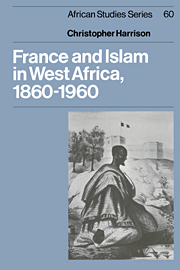Book contents
- Frontmatter
- Contents
- Acknowledgements
- Abbreviations
- Map
- 1 Introduction
- PART I 1850–1898: NINETEENTH-CENTURY ORIGINS OF FRENCH ISLAMIC POLICY
- Introduction
- 2 French Islamic policy in Senegal and Algeria
- PART II 1898–1912: THE FEAR OF ISLAM
- PART III FRENCH SCHOLARSHIP AND THE DEFINITION OF ISLAM NOIR
- PART IV 1920–1940: THE FRENCH STAKE IN ISLAM NOIR
- Notes
- Bibliography
- Index
- Frontmatter
- Contents
- Acknowledgements
- Abbreviations
- Map
- 1 Introduction
- PART I 1850–1898: NINETEENTH-CENTURY ORIGINS OF FRENCH ISLAMIC POLICY
- Introduction
- 2 French Islamic policy in Senegal and Algeria
- PART II 1898–1912: THE FEAR OF ISLAM
- PART III FRENCH SCHOLARSHIP AND THE DEFINITION OF ISLAM NOIR
- PART IV 1920–1940: THE FRENCH STAKE IN ISLAM NOIR
- Notes
- Bibliography
- Index
Summary
The French presence in West Africa dates back to 1637 and the establishment of a trading post in St Louis on the mouth of the River Senegal. For the next two hundred years the French remained on the coast where they competed with Dutch, English and Portuguese merchants for a share in the trade in slaves, gold, gum and animal hides. It was not until the early nineteenth century that the French began seriously to contemplate extending their influence to the interior of the country. Colonel Julien Schmaltz, appointed Governor of the colony in 1816, constructed forts in Bakel (1818–19), Dagana (1819) and Richard Toll (1824) which were intended to provide the infrastructure for the exploitation by French colonists of the Senegal River valley. However, construction of the forts met with fierce resistance and within a short space of time the projects for agricultural development were abandoned. French interest turned again to trade.
In the early nineteenth century the gum trade was the most lucrative trade of the region. Gum, which was extracted from the acacia trees which grew wild along the southern edges of the Sahara, was brought by Moorish traders to seasonal markets held in three riverside locations in the lower river valley.
- Type
- Chapter
- Information
- France and Islam in West Africa, 1860–1960 , pp. 9 - 10Publisher: Cambridge University PressPrint publication year: 1988



